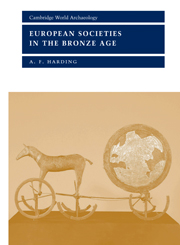Book contents
- Frontmatter
- Contents
- List of figures
- List of tables
- Preface
- 1 Introduction
- 2 The Bronze Age house and village
- 3 Burial
- 4 The domestic economy
- 5 Transport and contact
- 6 Metals
- 7 Other crafts
- 8 Warfare
- 9 Religion and ritual
- 10 Hoards and hoarding
- 11 People
- 12 Social organisation
- 13 The Bronze Age world: questions of scale and interaction
- 14 Epilogue
- References
- Index
14 - Epilogue
Published online by Cambridge University Press: 25 January 2010
- Frontmatter
- Contents
- List of figures
- List of tables
- Preface
- 1 Introduction
- 2 The Bronze Age house and village
- 3 Burial
- 4 The domestic economy
- 5 Transport and contact
- 6 Metals
- 7 Other crafts
- 8 Warfare
- 9 Religion and ritual
- 10 Hoards and hoarding
- 11 People
- 12 Social organisation
- 13 The Bronze Age world: questions of scale and interaction
- 14 Epilogue
- References
- Index
Summary
The preceding chapters have presented some aspects of the archaeological record for Bronze Age Europe, and no simple summary can do justice to them. It is evident, however, that a number of distinct spheres of activity may be recognised in Bronze Age research. Some of these are ‘nuts-and-bolts’ approaches (i.e. site- and artefact-based), while others are more theoretical in nature. While the trend is from the former to the latter, in many countries the study of cultures, for the purposes of ethnogenesis and culture history, still reigns supreme.
Typology and artefact studies. The enormous wealth of material culture in the Bronze Age naturally means that attention has focused on the products of the smith and the potter, sometimes to the exclusion of all other objects of study. Of the many examples which one could cite, the series Präistorische Bronzefunde (PBF) is preeminent. So far only one category of objects – swords – is even reasonably complete across Europe (and even there gaps remain), but others, such as metal vessels, are not far behind. There are, however, drawbacks to this approach. The objects, when drawn together on a page, lose their contextual information. It is also misleading to present only finds of bronze, when identical objects might be made in wood, gold or iron, or other materials.
[…]
- Type
- Chapter
- Information
- European Societies in the Bronze Age , pp. 431 - 435Publisher: Cambridge University PressPrint publication year: 2000



